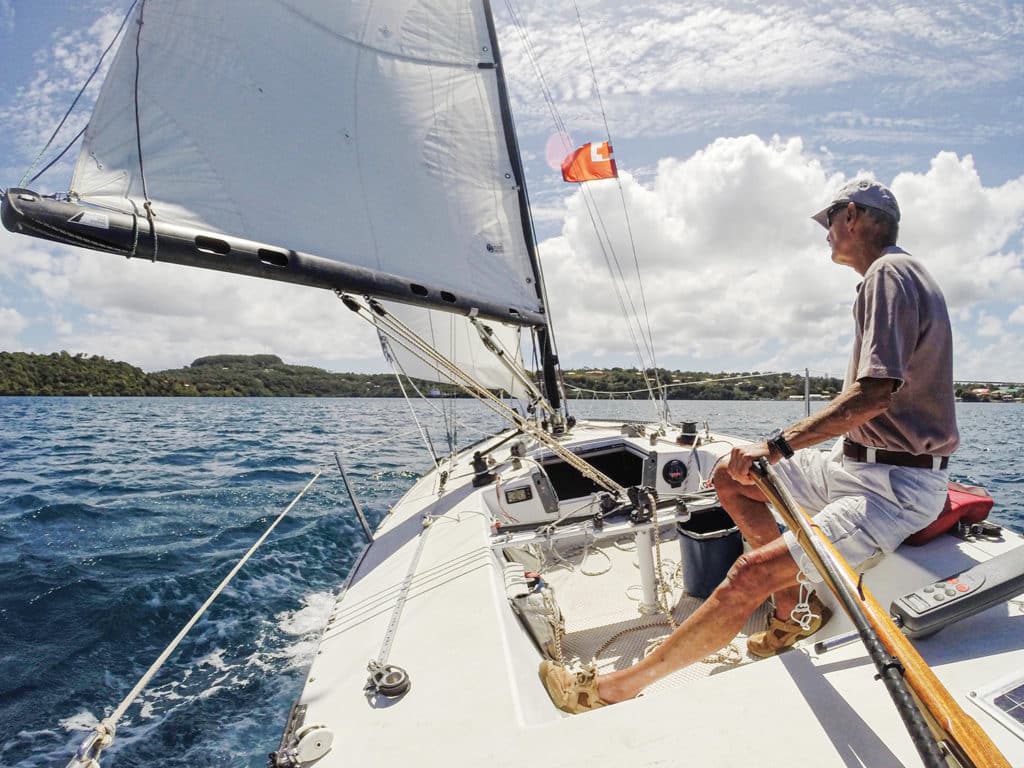
Last year, I completed my sixth circumnavigation. Not a statement you hear every day. I deliberately chose to make this voyage in Gannet, an ultralight Moore 24, because I wanted a new-to-me experience, and it was. I have sailed an even smaller and more radical boat, Chidiock Tichborne, an 18-foot Drascombe Lugger, most of the way around the world, but Gannet is different, and I learned some things along the way that might be of interest and use to others.
The Unexpected
Gannet has only 2 feet of freeboard. I knew she would be wet, but she was even wetter. Until I installed a spray hood over the companionway in Durban, South Africa, water poured below even with the hatches closed. I have written that there is waterproof and there is Gannet-proof, which is exceeded only by that of submarines, one of which she often resembles.
Fortunately, I do not get seasick, but I have never before stepped ashore after a passage and felt the land move. Gannet’s acceleration is so fast and her motion so quick, that even after a short passage, I always felt the land move for several hours—most noticeable when I closed my eyes in the shower.
Biggest Improvements
I made the most significant major improvement after I reached New Zealand, when I removed the traveler bridge from the cockpit, put the traveler on the cockpit sole, and installed a pedestal for the main sheet and backstay control line. Stepping over the bridge was always inconvenient, and at sea sometimes hazardous. Removing it opened up the cockpit and made sailing Gannet easier and safer.
The second major improvement was adding the spray hood. I made several unsuccessful attempts to reduce the ingress of water around the companionway, but it was not until a Dutch sailor sent me photos of a simple spray hood he had built for his own boat that I found a design that would work and still be easily and quickly raised and lowered, even from inside the cabin. After it was in place, some water still made its way below, but much less.
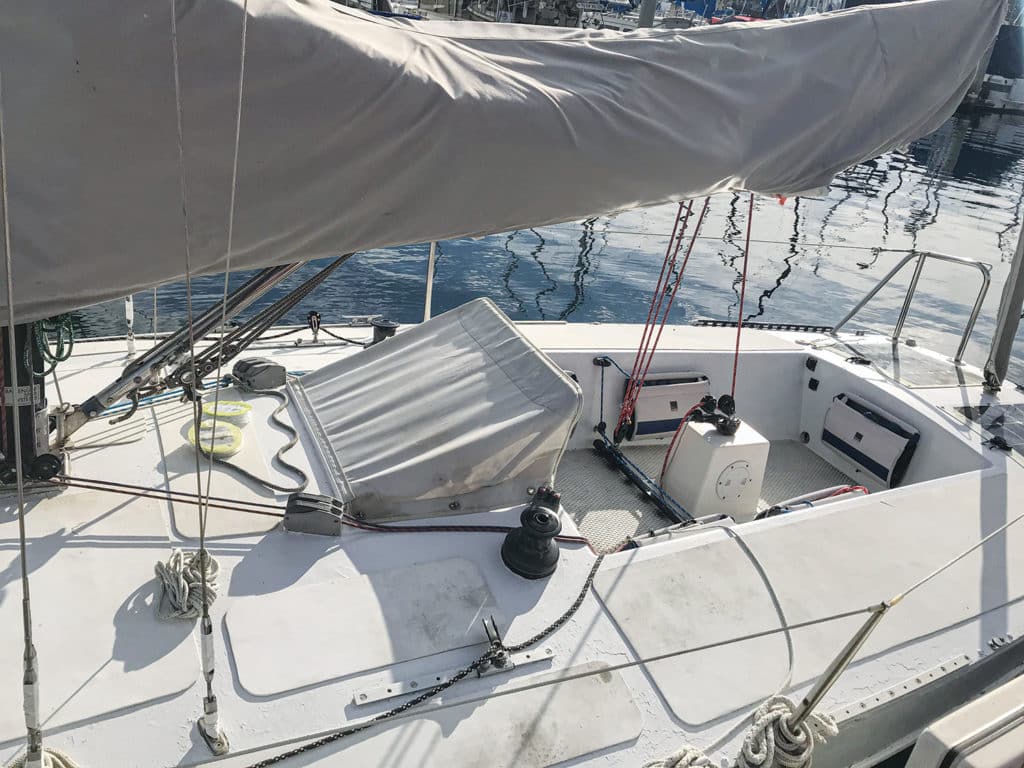
The third-biggest improvement was made both in New Zealand and in Marathon, Florida, when I replaced my sails. I had used the same sailmaker for many years, but he made serious mistakes with my last two orders. He is now retired.
In New Zealand, I replaced the asymmetrical with a North Sails G2. I wanted a sail that I could use beam reaching as well as running. I chose North because they had a loft at Opua, in the Bay of Islands. When the sail arrived, I was impressed by how superior the workmanship was over the old sail, and when I used it, how superior the performance. Cut lower than the old sail, it did not furl evenly with my Facnor gennaker furler, so I replaced that with a ProFurl Spinex top-down furler on which the sail has always furled perfectly.
By the time I reached Marathon, Florida, three years and more than 20,000 miles into the voyage, the mainsail was showing signs of UV degradation, so I decided to replace it and the furling jib. Having had a good experience with the G2, I contacted North and bought from them a new main and jib made with their 3Di process. Again, the workmanship is excellent.
North’s 3Di sails are laminated, not sewn, and I have never had anything like them. When I first bent them on, they were like sheet metal. They have since become more pliable. I even got the jib back into a sail bag in Panama. They show no wear after 7,000 miles and seem to be almost indestructible.
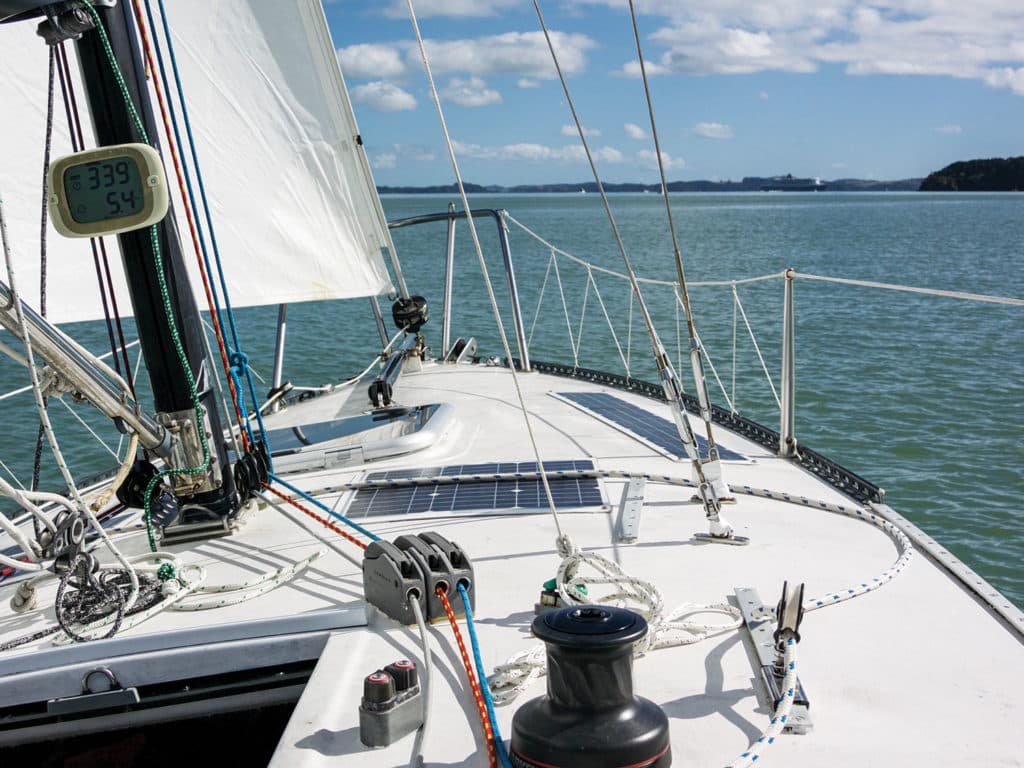
A fourth modification was the addition of running backstays. For decades I have often sailed my boats under headsail alone but always on masthead rigs. Gannet is the first fractional rig I have owned, so after reaching Honolulu, I emailed Buzz Ballenger, who made Gannet’s spars, asking his advice, which was to add running backstays to keep the mast from pumping.
I did, and used them during passages whenever I did not have the main set, and sometimes even when it was. Whether this was critical I do not know. But the mast stayed up through many gales and several masthead-in-the-water knockdowns.
What Worked
Most equipment functioned properly. This is about that which functioned especially well.
Sheet-to-tiller steering: I have written about this before in this magazine. It is simple, inexpensive, and steers the boat from a close reach to a broad reach. Sheet-to-tiller steering was used for more than half of the 30,000 miles Gannet covered during the circumnavigation.
Tiller pilots: This will come as a surprise to those who know how many tiller pilots failed during the voyage. I am going to include them in what did not work too.
I had two different makes of tiller pilot on board, a Pelagic and numerous Raymarines, some ST1000s, some ST2000s. I like the design of the Pelagic with the electronics in boxes below deck and the motor mounted in a tube above the housing for the tiller arm. In my experience, tiller pilots fail when water gets into the housing through the opening around the tiller arm, which cannot be totally watertight.
The Pelagic worked in gale-force conditions, which killed the Raymarines. However, mine, being a prototype, suffered from gremlins that I expect will have been eliminated from production models. The past two times I tried to use it, it began to operate properly, but within minutes, spontaneously went into standby mode, which rendered it useless.
RELATED: A Slow Journey North
I do not know how many Raymarines failed. I usually had four on board. I once sent three at one time back for repair under warranty. The first gave me false confidence, lasting 4,000 miles from San Diego to most of the way through the passage from Honolulu to Apia, Samoa, when it was swamped in a knockdown (see “Most Dangerous Moments,” p. 49). The last withstood almost all the way from Balboa, Panama, to San Diego before it quit one night. After reaching San Diego, it resumed functioning. If they can be kept reasonably dry, Raymarines do a good job, particularly in air too light for sheet-to-tiller steering.
I did not put a self-steering vane on Gannet because the cost of reinforcing the transom and the vane would have been as much as I paid for the boat. I thought I could buy a lot of tiller pilots for that amount, and I did. I also knew that I could use sheet-to-tiller steering.
I do not regret the decision not to have a vane.
Solbian solar panels: I had six 25-watt panels of a different brand, all of which failed (see below). Tired of replacing them, in Australia I bought two Solbian panels. They are slightly larger than the 25-watt panels but are rated at 50 watts. When the remaining Aurinco panels failed, I replaced them with two more 50-watt Solbian panels. They have functioned properly, and none has yet failed. Each panel is wired to its own voltage booster/regulator, thanks to excellent advice I received from Tom Whitehead at Ocean Planet Energy.
Yellowbrick tracker: I bought the Yellowbrick tracker so that my wife, Carol, could follow my passages. Others seemed to like to do so too, and I have found that after passages, I enjoy viewing Gannet’s track. Although the devices are waterproof, again Gannet is wetter than waterproof, and after water got into the charging port when the unit was mounted on the stern pulpit—a problem fixed free of charge by Yellowbrick although my unit was no longer under warranty—I mounted it in the cabin near the companionway where it has a view of the sky. It has since been totally reliable. I have only to set it to transmit our position at the interval I choose, and turn it on at the beginning of a passage and off at the end.
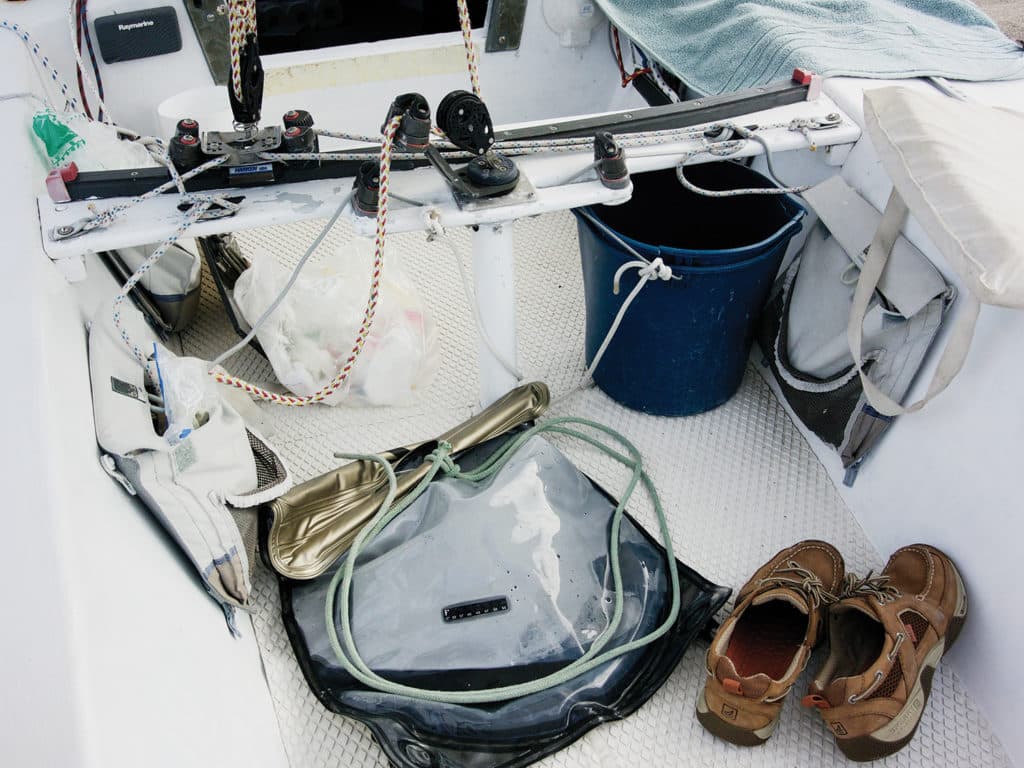
Yellowbrick’s support is outstanding. In addition to the charging-port repair, I had occasion to email them questions two or three times. In each instance, I received a useful reply in hours.
iPhone and iNavX: This combo was my primary chart plotter, and completely satisfactory. In South Africa, a sailor introduced me to iSailor, which I also installed. It too does everything I need, but the charts for Gannet’s circumnavigation would have cost hundreds of dollars more from iSailor than iNavX. I also had the apps and charts on an iPad, and C-Map 93 charts in my MacBook, but I primarily used the iPhone. I made my first two circumnavigations navigating with a sextant, and I have one on Gannet, just in case.
Velocitek ProStart: The mast-mounted ProStart was my on-deck source of speed-over-ground and course-over-ground. In the Great Cabin, I read its data on my iPhone. I found it accurate and readable from anywhere in the cockpit.
Jetboil flash stove: I do not cook beyond heating water. The Jetboil does this quickly. Mine is not gimbled. I set it on the cabin sole and hold it with one hand for the minute it takes to boil 2 cups of water. I bought a case of 24 gas canisters before I left San Diego; I still have six left.
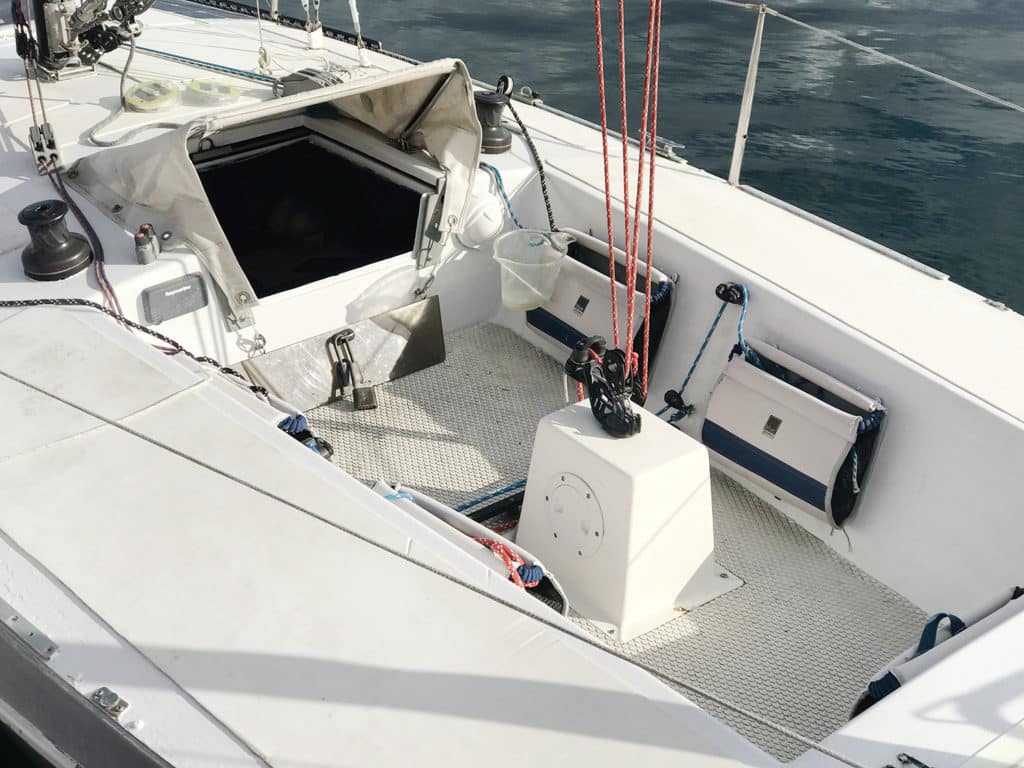
Pelican cases: Everything on Gannet is subject to getting wet, and if it can be damaged by water, must be stored in at least theoretically waterproof containers. Pelican cases have successfully protected my MacBook, iPad Pro and some camera gear. Cases made by Plano have also been effective.
Torqeedo outboard: Gannet does not need to power far or fast, and the electric Torqeedo meets our needs without the hazard and smell of gasoline and oil.
Usually I wait to mount the Torqeedo until I reach smooth water inside a harbor. However, the morning I expected to reach Durban, South Africa, the ocean went flat for an hour, and I took advantage of the calm to mount the Torqeedo. After doing so, I tilted it out of the water, which necessitates removing what Torqeedo calls the tiller arm. Doing so exposes the connectors on the battery to the tiller arm and the drive shaft. The calm soon turned into a 55-knot gale that caused us to lie ahull for 36 hours, during which those connectors were repeatedly inundated. Not surprisingly, they subsequently failed. I bought a new Torqeedo, and it has always functioned properly.
UE Boom 2 Bluetooth speakers: These are waterproof and nearly indestructible, with good stereo sound via their app.
GoPro Hero 5 Black: This is the first GoPro I have liked. Linear mode gets rid of the distorted wide-angle curves, and the touchscreen makes going through menus painless. At the request of others, I began to shoot video halfway through the circumnavigation. I wish I had started from the beginning.
I also shot with my iPhone and a Nikon AW1. On the last full day of the voyage, I started to shoot a video with the Nikon. After a few minutes the battery died, so I shot the rest on the GoPro. Comparing the footage from both cameras afterward, the GoPro’s is dramatically superior.
What Didn’t Work
Aurinco solar panels: I had six 25-watt deck-mounted Aurinco solar panels. All failed. I replaced several. All replacements failed. Aurinco is no longer in business.
Tiller pilots: See above.
Raymarine wireless wind system: In part, this was due to the masthead going in the water three times, for which no instruments are designed. But replacement units also failed without being dunked.
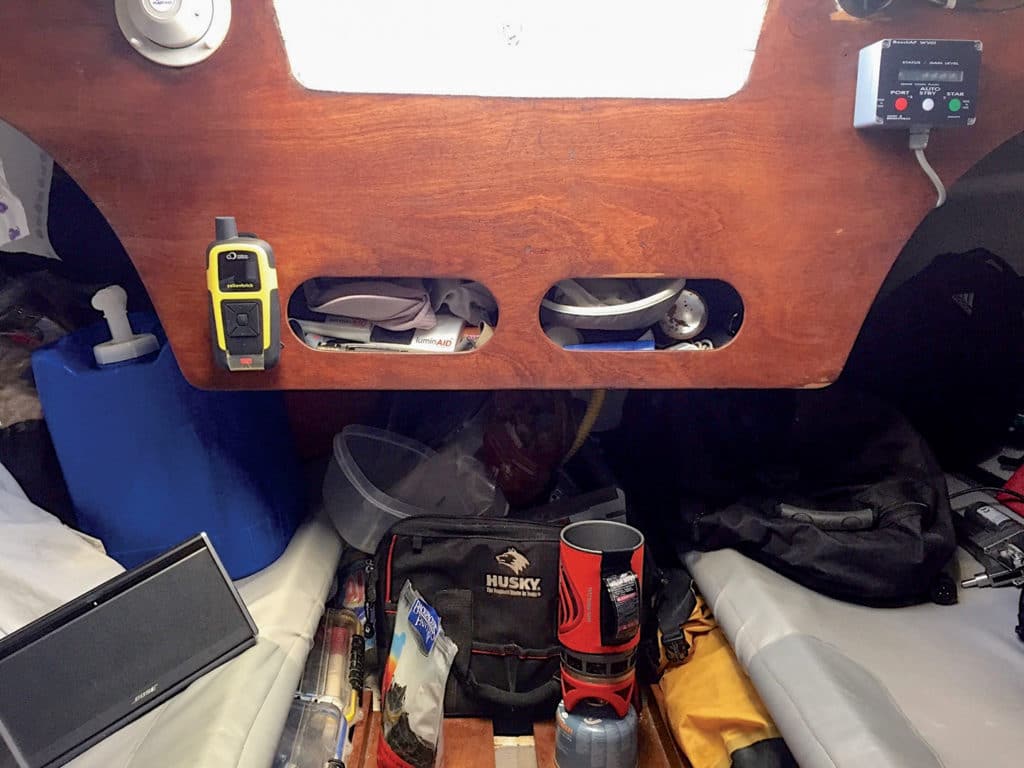
Invaluable Kit
Three things I am glad I had and glad I didn’t use: a Jordan drogue, emergency rudder and a Stohlquist drysuit. Each of these cost about $1,000. Had I needed them at sea, the money would not have done me any good in my checking account.
The Best Passage
The best passage was the first, from San Diego to Hilo, Hawaii. This is to be expected. Once Gannet broke free of the coastal weather, it was trade winds the rest of the way, and she had her only 1,000-mile week.
The Worst Passage
The worst passage unquestionably was the last, from Balboa, Panama, to San Diego, which saw five of the six slowest weeks of the entire circumnavigation (see “The End of Being,” January 2020).
My Biggest Mistake
Despite the fine sailing on that first passage, my biggest mistake was sailing to Hawaii instead of the Marquesas Islands because it changed the wind angle for thousands of miles afterward, causing us to have the wind forward of the beam, when from the Marquesas on across the Pacific, it would have been aft.
The Most Dangerous Moments
The most dangerous moments occurred during the voyage’s first year. At just after noon, 350 miles north of Apia, Samoa, I was standing in the companionway when I saw two 10-foot waves coming at us, high above the average 4-foot waves. They were steep and close together. As the first one hit, I ducked below, sliding the companionway over me. However, the vertical slat was not in place and not reachable. The second wave exploded into and over us, knocking down Gannet, masthead almost in the water.
With Gannet heeled 90 degrees, I braced myself from falling and stared down at the ocean. Gannet’s lee rail was below water, the ocean only a few inches from entering the cockpit. The wave was gushing in and pressing us down. It was a matter of whether the ocean would reach the cockpit before Gannet came back up. Time slowed almost to a stop. Probably a few seconds passed. Gannet came back up.
The other most dangerous moments came during the gale the morning we reached New Zealand. Winds were measured at 55 knots ashore, and 10- to 12-foot waves slammed into our beam. I was hand-steering with only a scrap of furling jib set. Often the waves knocked me from where I was sitting on the starboard side of the cockpit to my feet where I was looking down at the ocean. I could not leave the tiller to go below for my safety harness, so I tied a sail tie around my right wrist and the other end to the toe rail. As long as my arm remained attached to my body, I would remain attached to Gannet.
In the 55-knot gale against the Agulhas Current off Durban, with waves reported at 20 feet, I did not feel in danger. Lying ahull, Gannet is a cork. I was wet and tired after a 6,000-mile passage and wanted the gale to end, but it was only a matter of waiting it out.
The Best Moments
The best moments were countless. Feeling the little boat catch a wave or a puff of wind and instantly accelerate from 6 knots to 10 or 12. Standing in the companionway listening to music and sipping a drink as she sped smoothly into the sunset. The clear night sky. The beautiful days. The purity of solitude. And the last morning, when at first light I looked across at San Diego’s Point Loma, 200 yards away, and felt the quiet satisfaction of having persevered and endured and completed the course.
Webb Chiles is a writer and sailor who has completed six circumnavigations in a variety of boats. You can read more about his adventures and stories at his website, inthepresentsea.com.








